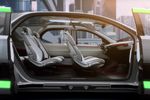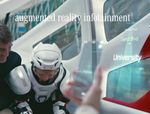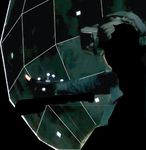Get to the Head: Why We Currently Miss the Full Potential of Head-Mounted Displays in Vehicles
←
→
Page content transcription
If your browser does not render page correctly, please read the page content below
Get to the Head: Why We Currently
Miss the Full Potential of
Head-Mounted Displays in Vehicles
Christian Mai Kai Holländer
LMU Munich LMU Munich
christian.mai@ifi.lmu.de kai.hollaender@ifi.lmu.de
ABSTRACT
Current concepts of automated vehicles include an increasing usage of internal infotainment displays.
Although being visually appealing, such display concepts introduce drawbacks in terms of ergonomics
– neck stress and unnatural interaction with a display in the side door – and increase the price.
Additionally, occupants of a vehicle often occlude screens for others or their seating orientation might
complicate viewing a specific display. Other design concepts introduce the usage of hand-held devices
to transmit information about the car. We propose to use augmented and virtual reality head-mounted
displays instead of fixed screens to overcome these issues. While concepts that based on displays
and handheld devices consequently design for the use of these devices, there are no concepts that
showcase interior designs for HMD usage. Current advances to use HMDs inside the car just showcase
the possibility to wear a headset while being in the car. Important questions for the interior concept,
such as the storage of HMDs, the integration with the existing HMD and the consequent use of
the interior to support interaction in VR, have not yet been addressed. We present two exemplary
scenarios that showcase the possible impact a consequent design for HMDs could have on the vehicles
interior. With our proposal we want to foster the discussion on the possibilities of HMDs and the
Figure 1: We present an example of how needs on the interior design to make use of the full potential of VR experiences in the car.
consequent consideration of HMD user
needs influences interior design. Surfaces CHI’19 Workshop on “Looking into the Future: Weaving the Threads of Vehicle Automation”, May 2019, Glasgow, UK
in the cars interior (within reach of passen- © 2019 Copyright held by the owner/author(s).
gers) could provide tactile feedback to im- This is the author’s version of the work. It is posted here for your personal use. Not for redistribution. The definitive Version of
prove in-vehicle VR experiences. Figure Record was published in Proceedings of CHI’19 Workshop on “Looking into the Future: Weaving the Threads of Vehicle Automation”.
shows a photomontage of [1] and [5].KEYWORDS
head-mounted displays; autonomous vehicles; automotive; interior design
POSITION STATEMENT
[A] The number of AV prototypes (SAE level 4 and 5 [10]) with a full interior concept increases steadily
(e.g, [2–4, 6, 8, 13, 15]). Figure 2 and Figure 3 show a selection of such interior concepts. In the following
sections, the letters included in Figures 2, 3 and 4 are used as references.
In a comparison of interior design and user interface concepts, we see a trend towards spacious
automated cars [A-H]. Some automated vehicles use the metaphors of luxury living or bedrooms
[A,C,E,F] for a single person. Other concepts aim on multiple persons using the car, e.g., families going
on holidays or strangers commuting to work [A,B,C,D,G,H].
[B] In both aforementioned levels of automation screens are used everywhere in the car. Interior
designers use panoramic screens in the door [A,C] or under the windshield [C], as tabletop displays
between the users, at the roof [A,B] or huge displays at the front window of the car [D]. For this
position paper we do not consider the specific information displayed, but concentrate on the interior
design for information visualization in general in the car.
We suspect that the decision for fixed displays was not made on the basis of ergonomics and
usability. In many concepts screens are placed in the car that are only visible in certain configurations
[C] [C,D]. Huge screens beneath the windshield are not usable if the front row passengers turn around
[C,D]. When sitting next to a door display, the angle to the display might be too steep to easily
see the screen [A,C] Additionally, less displays inside a vehicle provide more possible storage space
and reduce weight as well as maintenance effort. Hence, avoiding big hardware pieces could benefit
the environment and lower the price of future automated vehicles. From an ergonomic perspective,
most of these displays are not positioned according to standards that prevent stress for the viewer.
For example, screens positioned in the center stack, roof or door require turning the head [A,B,C,J].
Long-term use of such displays might stress the users neck and lead to injuries. Screens should be
positioned central to the user to avoid turning the head during usage. The interaction with door
[D] displays puts unnecessary load on the users body. Touching the horizontal surface on the door is
not possible without creating effort in the arm and upper body, since the user must turn the hand
Figure 2: Examples of displays in inte-
rior concepts of automated vehicles. Red
90 degrees inwards to perform touch gestures. Interaction with the other hand, away from the door,
arrows indicate the position of attached requires to detach the shoulder or even the back from the seat, creating yet another unnecessary
screens. A [13], B [6], C [3], D [8] physical effort.
The display technology and electronics must meet automotive standards in terms of: robustness
(e.g., vibrations), viewing angles, safety requirements and changing lighting conditions and further. To
overcome these issues, some concepts integrate mobile hand-held devices (Figure 3). However, these
2devices are just a substitutions of screens for private work and do not support group work. Important
to our argumentation is that the interior concepts shown in Figure 3 and 2, consequently integrate
those devices. For example they provide storage or charging spaces for handheld devices.
To overcome the issues introduced by the concepts of screen and hand-held based devices head-
mounted displays (HMDs) featuring either augmented or virtual reality are introduced. Rober et al.
already licensed a patent regarding an HMD used inside of a vehicle [17]. The company Holoride [I]
develops a standard that connects an XR device to the vehicle’s databus [1]. The scientific community
addresses the usage of HMDs in cars by publications (e.g., [11]) and workshops (e.g., [16]). Industry
showcases the usage of HMDs in cars (Figure 4). However, proposed concepts have focused on
[E] application design rather than making use of the interior to support the HMD usage. Figure 4 shows
exemplary that today HMD based applications are designed without making use of the interior. As
we demonstrate in Figure 1, the Holoride application [I] (Figure 4) could make use of the interior by
providing passive haptic feedback in order to improve interaction. Another example might be that AR
HMDs do not perform well in bright sunlight. The concept of Kun and colleagues [11] that provides a
skype chat via a Hololens, positioned above the center stack, might be supported by an interior that
offers a tidied up and dark background leading to more contrast in the visible image. We therefore
argue that the development of future in car HMD based applications should always consider the
interior design to create the best experience.
[F] We suggest to foster interior design for the integration of HMDs, as they will become more
available in the near future, are versatile to use, cost efficient and solve a number of ergonomic issues.
Furthermore, they enable a simple separation of passengers. Hence, users can have their own display or
collaborate with selected individuals. There are even strategies on how to enable collaboration of HMD
users and people without such a device in a mixed-presence scenario [12]. If required, all passengers
can be connected, which is particularly easy due to the very controllable environment of the vehicle
on network level. Additionally, the vehicle offers the advantage that people sit permanently in one
place. Through the consistent design of the interior, the interaction in VR can be clearly supported in
terms of efficiency and entertainment. Physical surfaces could support interaction through tactile
[G] [H] feedback. Redirected touch enables an infinite amount of touchable elements through a few physical
elements. Such physical elements only have to correspond slightly to the virtual ones to create the
illusion of interacting with the virtual object.
Figure 3: Examples for concepts without
traditional displays. As a replacement, mo-
bile devices are an integral part of the in- EXEMPLARY SCENARIOS
terior concept. Red arrows indicate the To support our argumentation, we present two examples on how to include the benefits of integrated
current position of mobile devices. E [15],
HMDs in automated vehicles interior design.
F [2], G [19], H [4]
3Example 1: Relaxation and Take Over Request
The usage of level 4 automation is restricted to certain environments, e.g. a highway. During this
period, drivers are likely to relax in the vehicle [14], which could be supported by using a VR HMD.
The passenger could be virtually floating on an air mattress in the ocean. The interior will provide
stimuli like air flow or changing the seating position as proposed by Rober et al. [17]. The car will
hand over control to the driver before leaving the highway. The driver therefore will need to take off
the HMD. The interior now needs to provide a space for that. If the device is brought by the user
there might be a storage in the center stack that also charges the HMD. If the HMD is part of the
interior it might be attached to the headrest of the seat. The car recognizes the removal of the headset
[I] and places the HMD mechanically in the headrest. It is safely stored there, disinfected and cleaned
and can be folded back over the user’s head at the push of a button. While the HMD is not in use, the
user follows the vehicle’s status via the traditional interface around the steering wheel.
Example 2: Virtual Office
In level 5 automation, the vehicle could become a driving office. Recreating a desktop work space via
virtual reality only requires a bluetooth keyboard [9]. When wearing an HMD the virtual environment
would recreate a private office adjustable to the users preferences. Cheng et al. [5] present how sparse
touch feedback can be implemented to improve the experience, comfort and performance. Their
[J] findings could be transferred to built a convincing work space within a vehicle, as we showcase in
Figure 1. The interior could support immersion by providing a small table for the keyboard and, for
example small handles to mimic drawers.
CONCLUSION
In this position paper we argue that a consequent car interior design for HMDs enable novel interaction
possibilities and helps to overcome current limitations of these HMD. Advances in the development
of AR and VR HMDs provide a strong alternative to displays and the potential of applications is
[K] recognized in related work. However, in contrast to screens and handheld devices, there are hardly
any investigations regarding interior design specifically built for the use of HMDs. Hence, we want to
provoke a discussion on how consequent interior design could support the usage of HMDs in future
autonomous vehicles. Exemplary questions to be considered for consequent interior design are: How
Figure 4: Examples of HMDs in automated
vehicles. I [1], J [18], K [7] will we integrate HMDs in the interface concept of a car? Do people favor personal devices or should
the HMD be an integral part of the car? Where is information about the vehicle presented and should
the information presentation be supported by the interior design? Are there particular needs for the
interior design in critical situations like a take-over request when wearing an HMD? Can safety and
well-being while wearing an HMD be supported by the interior design?
4REFERENCES
[1] Audi AG. 2019. Holoride. https://blog.audi.de/wp-content/uploads/2019/01/
Virtual-Reality-Testfahrt-holoride-Mann-mit-VR-Brille-im-e-tron-768x512.jpg
[2] BMW AG. 2018. Der BMW Vision iNEXT. Die Zukunft im Visier. https://www.bmwgroup.com/de/innovation/
bmw-vision-i-next.html
[3] Daimler AG. 2015. mercedes-benz-f-015-luxury-in-motion-concept-car-interior. http://img.benzspirit.com/full/
2735e17e31d95f35-2016-mercedes-benz-f-015-luxury-in-motion-concept-car-interior.jpg
[4] Daimler AG. 2018. Vision URBANETIC. https://media.daimler.com/marsMediaSite/de/instance/ko.xhtml?oid=41169005&
relId=1001&resultInfoTypeId=172#toRelation
[5] Lung-Pan Cheng, Eyal Ofek, Christian Holz, Hrvoje Benko, and Andrew Wilson. 2017. Sparse Haptic Proxy: Touch
Feedback in Virtual Environments Using a General Passive Prop. In Proceedings of the 2017 CHI Conference on Human
Factors in Computing Systems (CHI ’17). ACM, New York, NY, USA, 3718–3728. https://doi.org/10.1145/3025453.3025753
[6] Chrysler. 2017. The Chrysler Portal Concept. https://www.fcagroup.com/en-US/media_center/insights/Pages/chrysler_
portal_concept.aspx
[7] Alex Davis. 2015. Mini’s Working on Augmented Reality Driving Goggles. https://www.wired.com/2015/04/
minis-working-augmented-reality-driving-goggles/
[8] Designboom. 2018. Meet Sedric: Volkswagen’s self-driving pod with a friendly face. https://www.designboom.com/
technology/volkswagen-sedric-self-driving-03-07-2017/
[9] Jens Grubert, Eyal Ofek, Michel Pahud, and Per Ola Kristensson. 2019. The Office of the Future: Virtual, Portable, and
Global. IEEE Computer Graphics & Applications 38, 6 (January 2019), 125–133. https://www.microsoft.com/en-us/research/
publication/the-office-of-the-future-virtual-portable-and-global/
[10] SAE International. 2014. J3016_201806: Definitions for terms related to on-road motor vehicle automated driving systems.
SAE Standard. https://doi.org/10.4271/J3016_201401
[11] Andrew Kun, Hidde van der Meulen, and Christian Janssen. 2017. AM Calling While Driving : An Initial Experiment with
HoloLens.
[12] Christian Mai, Sarah Aragon Bartsch, and Lea Rieger. 2018. Evaluating Shared Surfaces for Co-Located Mixed-Presence
Collaboration. In Proceedings of the 17th International Conference on Mobile and Ubiquitous Multimedia. ACM, 1–5.
[13] Panasonic. 2018. Autonomous Living Space Cabin. https://na.panasonic.com/us/automotive-solutions/autonomous-0
[14] Bastian Pfleging, Maurice Rang, and Nora Broy. 2016. Investigating User Needs for Non-Driving-Related Activities During
Automated Driving. In Proceedings of the 15th International Conference on Mobile and Ubiquitous Multimedia (MUM ’16).
ACM, New York, NY, USA. https://doi.org/10.4271/J3016_201401
[15] Renault. 2018. 2018 Paris Motor Show - Renault EZ-ULTIMO : Inspired by French Design. https://group.renault.com/en/
news/blog-renault/renault-ez-ultimo-inspired-by-french-design/
[16] Andreas Riener, Andrew L. Kun, Joe Gabbard, Stephen Brewster, and Andreas Riegler. 2018. ARV 2018: 2Nd Workshop on
Augmented Reality for Intelligent Vehicles. In Adjunct Proceedings of the 10th International Conference on Automotive User
Interfaces and Interactive Vehicular Applications (AutomotiveUI ’18). ACM, New York, NY, USA, 30–36. https://doi.org/10.
1145/3239092.3239096
[17] Mark Rober, Sawyer Cohen, Daniel Kurz, Tobias Holl, Benjamin Lyon, Peter Georg Meier, Jeffrey Riepling, and Holly
Gerhard. 2018. Augmented virtual display. US Patent App. 15/713,421; Publication number: 20180089900.
[18] Scott Scanlon. 2017. VR and self-driving cars are a fascinating, scary combo. https://www.youbrandinc.com/virtual-reality/
vr-and-self-driving-cars-are-a-fascinating-scary-combo/
[19] Yanfeng. 2017. Experience in Motion 2017 Demonstrator. https://www.yfai.com/en/xim17
5You can also read



























































